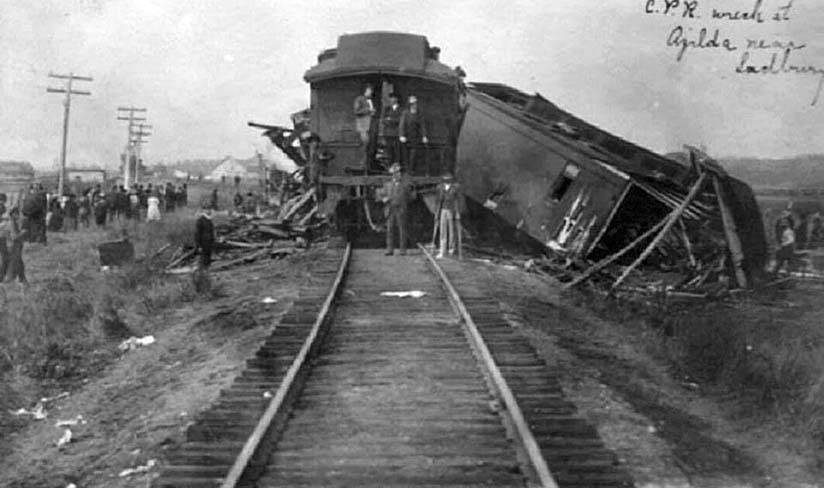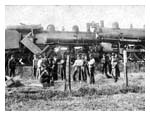
Sudbury Ontario - News stories about deadly train crashes with the dateline Sudbury made the front pages of newspapers coast to
coast and in the United States more than a century ago.
A train crash killing 12 people took place in Azilda in the early morning of Wednesday, 12 Sep 1906.
in the early morning of Wednesday, 12 Sep 1906.
At the time, it was one of the worst Canadian Pacific Railway (CPR) crashes on record.
A few years later, a westbound train out of Sudbury derailed on the Spanish River trestle bridge.
It remains one of the deadliest train accidents in Canadian history.
A newspaper report at the time of the Azilda crash described, "two ponderous locomotives locked in a deadly embrace."
Many of the 100 passengers on the westbound CPR train out of Toronto were still sleeping in their berths, or having breakfast in the dining car when
it was hit by an eastbound transcontinental express known as the Imperial Limited about 07:15.
The westbound train, referred to as a "Harvester Special," was attempting to take the siding to clear the track and allow the Imperial the
right of way to pass when the accident occurred.
The Imperial locomotive hit the Harvester head on, smashing its baggage car and pushing it backward into a crowded passenger car.
Twelve people were killed and least 25 injured on the Harvester.
No one on the Imperial was injured.
An insulated boxcar carrying salmon between the locomotive and the passenger coaches took the impact of the crash.
It was pouring rain and the tracks were slippery.
The conductor of the Imperial said the train's brakes "refused" to work.
The crew escaped injury by jumping off the train.
Doctors and volunteer emergency workers arrived from Sudbury to help the injured, assist the crew, and uninjured passengers.
Many were trapped in their seats by piles of luggage.
A train was dispatched to deliver the dead and injured to hospital in Sudbury.
Shaken travellers from both trains were transported to Sudbury.
Many decided to return home rather than continue their journeys.
Reporters sought out survivors at the train station for eyewitness accounts of the bloody crash.
Among the dead were two sisters, aged 12 and 14, from Perth County.
The girls were seated together in front of their parents, who survived the crash.
A woman passenger on the Imperial told reporters, "The whole scene was shocking, but I think the most painful of all was the spectacle of a
woman who had her toes cut off, and I believe her leg broken, and two little children lying dead beside her. She lay there, I think for two hours,
before she was extracted from the wreckage. The cries of the injured all around were most heartrending."
Percy Baker, 24, was heading west to Regina when tragedy struck.
He and his cousin, Charles Baker, were hoping to earn some money farming in Saskatchewan.
They planned to help harvest wheat for three or four weeks before returning home to Stayner.
Baker was killed but his cousin escaped serious injuries.
It took most of the day for wrecking crews from North Bay and Sudbury to clear the tracks.
General Superintendent Brady of the Lake Superior division issued the following statement, "I was over the ground, and I know that no one was to
blame for the accident. There was no negligence. There was no mistake. It was simply a mechanical failure. Both trains intended to stop. In fact, both
trains were where they ought to have been. The train going west had halted two-car lengths from the east end of the switch, which is 2,500 feet long.
The train going east was to stop four-car lengths from the westbound train to allow the latter to enter the siding. The eastbound train was not going
fast, and Engineer Thurlow put on his air brakes, but owing to a closed angle-cock, only the engine, refrigerator, and mail cars responded, and the
train telescoped."
Four years later, another deadly train crash occurred in Nairn Township on 21 Jan 1910.
At about 13:00 a westbound CPR passenger train, the No. 7 Soo Express, carrying 100 passengers, derailed on the trestle bridge crossing the Spanish
River.
The first-class coach, dining car, and a sleeping car derailed and plunged into the frozen river.
First-class passengers were trapped inside the coach and all but one drowned.
The second-class coach became detached and rammed into the bridge.
About 20 people were believed to have been burned when its oil heaters burst into flame.
The inquest could not determine the cause of the accident.
Nor is it clear from various reports the sequence of events.
Did the front of the train leaving the tracks cause the second-class passenger to hit the bridge?
Or did the impact of hitting the bridge cause the train to split and front cars to derail?
There was much confusion at the scene with reports at the time estimating the number killed at 70.
Other accounts said 43 people died.
Public Safety Canada's website records 63 people were killed and another 20 injured.
Sudbury lumber baron William Bell was on the injured list.
He received cuts and bruises but was not hospitalized.
Bell was one of the 14 passengers in the submerged dining car who was pulled from a hatch in the roof by conductor Thomas Reynolds.
At the inquest, held in Sudbury, the jury questioned whether three section men were sufficient to keep the 13 kilometre section of track safe during
winter conditions, and identified a lack of emergency equipment and exits.
They recommended openings be placed in coach ceilings to allow passengers to escape from overturned cars in the case of accidents.
The Spanish River derailment remains one of the deadliest train accidents in Canadian history.
Vicki Gilhula.
(there was no image with original article)
(usually because it's been seen before)
provisions in Section 29 of the Canadian
Copyright Modernization Act.










